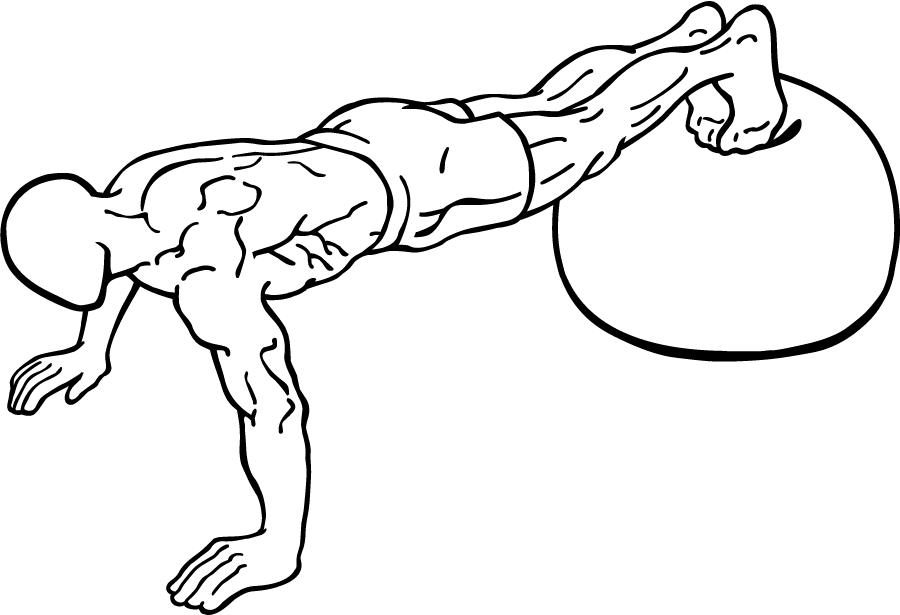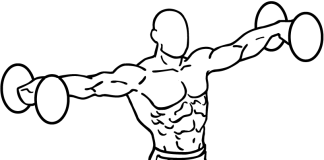Last Updated on September 26, 2014
The Push-Ups with Feet on an Exercise Ball is an advanced variation of the traditional push-up that incorporates balance, stability, and core strength. By elevating your feet on an unstable surface like an exercise ball, this exercise not only targets the chest, shoulders, and triceps but also engages the core muscles, including the rectus abdominis, transverse abdominis, and obliques. This exercise is perfect for anyone looking to increase the challenge of their push-up routine, improve core stability, and enhance overall upper body strength.
In this comprehensive guide, we’ll cover everything you need to know about push-ups with feet on an exercise ball. We’ll go through the benefits, proper technique, muscle groups worked, common mistakes, modifications, and tips to maximize the results. By the end, you’ll have a complete understanding of how to execute this powerful move and how to incorporate it into your workout for optimal results.
Benefits of Push-Ups with Feet on an Exercise Ball
1. Enhanced Core Stability and Strength
Balancing your feet on an exercise ball forces your core muscles to work harder to stabilize your body throughout the movement. This results in greater engagement of the core, improving strength in the rectus abdominis, transverse abdominis, and obliques.
2. Increased Upper Body Activation
The inclined position created by the elevated feet places extra emphasis on the upper chest and shoulders. This variation is particularly effective for building strength and definition in the upper chest and front deltoids.
3. Improved Balance and Coordination
Using an exercise ball introduces an element of instability, challenging your balance and coordination. This makes the exercise excellent for developing proprioception, which is your body’s ability to sense its position and movement in space.
4. Versatile and Accessible
All you need is an exercise ball and a flat surface, making this exercise easy to do at home, the gym, or even outdoors. It’s an effective bodyweight exercise that can be scaled up or down based on your fitness level.
5. Engages Lower Body Muscles
While primarily an upper body and core exercise, balancing your feet on the ball also activates stabilizing muscles in the legs, including the glutes and hamstrings, making this a true full-body movement.
Muscles Worked in the Push-Up with Feet on an Exercise Ball
- Pectoralis Major (Chest): The main chest muscle, responsible for pushing the body away from the ground.
- Deltoids (Shoulders): The anterior (front) part of the shoulder is heavily engaged, adding strength and stability to the movement.
- Triceps Brachii (Back of Arms): The triceps extend the elbows during the push-up, building arm strength and tone.
- Core Muscles:
- Rectus Abdominis: The “six-pack” muscle, helps stabilize the body and maintain a straight line.
- Transverse Abdominis: The deep core muscle that wraps around the torso, contributing to core stability.
- Obliques: The side abdominal muscles help with rotational stability and balance.
- Glutes and Hamstrings: The muscles in the lower body are engaged to keep the legs straight and steady on the exercise ball, contributing to stability.
Step-by-Step Guide to Performing Push-Ups with Feet on an Exercise Ball
Step 1: Set Up the Exercise Ball
Choose an exercise ball that’s properly inflated and able to support your weight. A slightly larger ball (55-65 cm) works well for most people, as it provides adequate height and stability for this exercise.
Step 2: Position Yourself on the Ball
Place the tops of your feet and shins on the exercise ball. Your legs should be straight, with the exercise ball under your shins to create a stable base. If you’re new to this exercise, you may find it easier to position the ball closer to your knees for more support.
Step 3: Set Your Hand Placement
Position your hands on the floor shoulder-width apart, with your hands directly under your shoulders. This alignment ensures that you’re engaging the chest, shoulders, and triceps evenly.
Step 4: Engage Your Core
Before starting the push-up, engage your core by tightening your abdominal muscles. This will help you maintain a straight line from your head to your feet, preventing your lower back from sagging.
Step 5: Lower Your Chest to the Floor
Inhale as you slowly bend your elbows and lower your chest toward the ground. Keep your elbows at a 45-degree angle to your torso, and avoid flaring them out to the sides. Focus on controlling the movement and maintaining balance.
Step 6: Push Back Up
Exhale as you press through your hands to extend your elbows and push your body back to the starting position. Pause briefly at the top, ensuring that your core remains tight and your body is stable.
Tip: Keep your gaze slightly forward, rather than looking down, to help maintain a neutral spine.
Common Mistakes to Avoid
- Allowing the Lower Back to Sag
- Sagging in the lower back can strain your spine and reduce the effectiveness of the exercise. Engage your core to keep your body in a straight line from head to heels.
- Flaring the Elbows Out
- Flaring your elbows to the sides puts unnecessary strain on your shoulders. Keep your elbows at a 45-degree angle to your body to protect your joints and target the chest muscles effectively.
- Using Momentum
- It can be tempting to use momentum to push yourself back up, but this reduces muscle engagement. Perform each rep slowly and focus on control to maximize the benefits.
- Losing Control of the Ball
- Keeping your feet steady on the ball can be challenging, but maintaining control is key. Start with a lower number of reps if necessary, and practice steady movements.
- Placing the Hands Too Far Forward or Back
- Ensure that your hands are directly under your shoulders for proper alignment. Placing them too far forward or back can make balancing more difficult and strain your wrists.
Variations of Push-Ups with Feet on an Exercise Ball
To add variety and continue progressing, try these variations:
1. Single-Leg Push-Up with Feet on Exercise Ball
Lift one foot off the exercise ball and perform the push-up with just one leg on the ball. This variation increases the challenge for your core and stabilizing muscles, helping to build even greater balance and control.
2. Decline Push-Up with Exercise Ball
Move the exercise ball further down toward your ankles or feet. This increases the incline, shifting even more focus to the upper chest and shoulders.
3. Push-Up to Pike with Exercise Ball
Perform a push-up as usual, then, while in the top position, use your core to lift your hips toward the ceiling, forming a pike position. This variation intensifies core engagement and adds an element of flexibility to the exercise.
4. Elevated Feet Clap Push-Up
After pushing up, briefly lift your hands off the ground and clap them together before landing back in the starting position. This plyometric variation adds a power element and tests your balance and coordination.
5. Push-Up to Knee Tuck with Exercise Ball
After completing a push-up, pull your knees toward your chest by rolling the ball forward. This move works the lower abs and adds an extra core-focused element to the exercise.
How to Incorporate Push-Ups with Feet on an Exercise Ball into Your Workout
The push-up with feet on an exercise ball is a versatile exercise that can be included in an upper-body, core, or full-body workout. Here’s a sample workout that integrates this exercise to maximize chest, shoulder, and core strength:
Sample Workout with Push-Ups with Feet on an Exercise Ball
1. Push-Up with Feet on Exercise Ball
- Sets: 3 | Reps: 10-12
2. Dumbbell Bench Press
- Sets: 3 | Reps: 8-10
3. Overhead Shoulder Press
- Sets: 3 | Reps: 10-12
4. Bicycle Crunches
- Sets: 3 | Reps: 15-20 per side
5. Mountain Climbers on Exercise Ball
- Sets: 3 | Time: 30 seconds
Cool-Down: Stretch your chest, shoulders, core, and hamstrings to improve flexibility and prevent muscle tightness.
Tips for Maximizing Results with Push-Ups on an Exercise Ball
1. Prioritize Form Over Speed
To get the most out of this exercise, focus on a slow and controlled movement. This ensures better muscle engagement, balance, and core stability.
2. Use Your Core to Stabilize
Remember to actively engage your core throughout the movement. This will prevent your lower back from sagging and keep your body aligned, improving both effectiveness and safety.
3. Increase Reps Gradually
Push-ups on an exercise ball can be challenging. Start with a manageable number of reps, and gradually increase as you become more comfortable with the balance and strength required.
4. Experiment with Different Ball Positions
Positioning the ball closer to your knees makes the exercise easier, while moving it closer to your feet increases the challenge. Adjust the ball position based on your current fitness level.
5. Focus on Breathing
Breathing helps stabilize your body and maintain control. Inhale as you lower yourself toward the ground, and exhale as you push up.
Frequently Asked Questions
1. What size exercise ball should I use for this push-up variation?
A medium-sized ball, typically 55-65 cm, works well for most people. The ball should be stable enough to support your legs while still providing a challenging level of instability.
2. How often can I do push-ups with feet on an exercise ball?
Two to three times a week is usually sufficient, with rest days in between to allow your muscles to recover.
3. Are push-ups with feet on an exercise ball suitable for beginners?
If you’re comfortable with standard push-ups, you can try this exercise. Beginners should start with the ball closer to the knees for more stability and progress over time.
4. Can this exercise replace bench presses?
Push-ups with feet on an exercise ball are effective but might not entirely replace bench presses if your goal is maximal chest strength. However, they’re a great complement for overall upper body strength and stability.
5. What should I do if I struggle with balance?
If balance is an issue, practice by placing the ball closer to your knees or performing the exercise next to a wall for support. As your balance improves, you can try more challenging variations.
Push-ups with feet on an exercise ball are a powerful exercise that combines upper body strength, core stability, and balance. This advanced push-up variation takes the classic move to the next level, engaging multiple muscle groups and improving functional fitness. By consistently including this exercise in your workout routine, you can expect improved chest and shoulder definition, a stronger core, and better overall coordination.
Remember to start with a comfortable level of elevation, prioritize good form, and gradually progress as your strength and balance improve. Whether you’re looking to increase the intensity of your push-up routine or add a new element to your upper body workouts, push-ups with feet on an exercise ball are a versatile and rewarding choice.
With dedication and practice, you’ll find this exercise to be an effective addition to your fitness routine, offering noticeable gains in both strength and stability. So grab an exercise ball, get into position, and take your push-ups to new heights!







